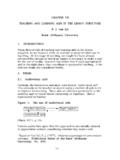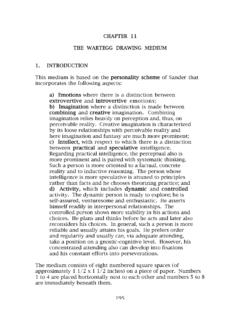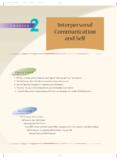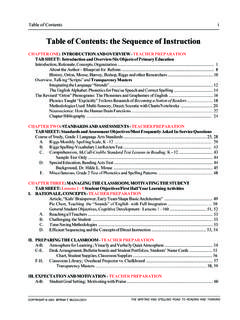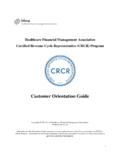Transcription of CHAPTER III PHASES OF A LESSON 1 ... - George Yonge
1 29 CHAPTER IIIPHASES OF A LESSONP. J. van der MerweGold City (Johannesburg) Teachers College1. introductory comments regarding THE course OFLESSONSS onnekus (1975, pp 55-56) says "the practice of giving a LESSON isaccomplished on the one hand by the course of instructing and onthe other by the course of learning. By course of instructing ismeant the teacher's guidance by means of instructing or unlockingreality. By course of learning is meant the child's self-actualizationof his learning initiative as learning potentiality or also openinghimself to the content." Related to this is the comment byOosthuizen (1971, p 28) that in order to acquire more certainty(also purposefulness) in instructing, it is important that the teacherbe able to give didactically accountable reasons for constructingeach phase of the LESSON . Van der Stoep (1972, p 130) says thatthe course of a LESSON is a matter of the form of a LESSON (1977, p 2) says that instructing is a matter of a relationshipwhere a particular way of relating (by teacher and pupil) isindicated by the course of the summary, a LESSON takes its course within a teaching- learning-relationship in terms of a LESSON plan designed in accordance withthe unique style of the teacher and within a theoreticallyparticularized fundamental (ground) structure or LESSON THE PHASES OF THE course OF LESSONSOn close examination, the apparently different opinions about thephases of the course of lessons show certain commonalities.
2 Forexample, Van Jaarsveld and Rademeyer (1973, pp 154, 160) declarethat a History LESSON has three PHASES , namely, an introduction,presentation, and finally an application or assimilation. Brunnhuberand Czinczoll (1974, pp 49-50) view the course of a LESSON as thedisclosure of a "here and now problem in its experiential richness",then from that "a problem for investigation is formulated", after30which they say, "the child employs the inquiry method and problemsolving" related in parallel with the classical methods of the socialsciences." From the investigation the child arrives at"generalizations and their own applications". Finally, the skills areevaluated and applied to new , Van Gelder's didactic model can be represented asfollows:beginning situationof the pupilsaimchoosing and orderingdidacticconsiderations aboutlearning contentground formslearning activities andtheoryteaching and learning aidsexecutiontestingWith reference to the above scheme, Van Gelder et al.
3 (1971)formulated the following LESSON sequence:I AimsII Beginning situation: level of knowledge; experiential worldIII Teaching-learning situation: (a) learning content: choosing andordering; (b) didactic work forms: learning and teachingaids31IV Procedures for carrying out the lessonV Determine the resultsVan der Stoep and Van Dyk (1977, pp 175-259) distinguish abeginning, a middle and an end phase. They explain further thateach phase has its own aims as well as modes of teaching andlearning by which the course of the LESSON is carried out. Of equalimportance is the comment by Swart (1977, pp 1-9) that each phaserevolves around the relationship by which it is actualized and isknown. With these statements by Van Dyk and Van der Stoep aswell as by Swart as a point of departure, a closer look is taken of thephases using the following classification:(a) The beginning phase(i) LESSON greeting(ii) Actualizing foreknowledge(iii) Stating the problem(b) The middle phase(i) Briefly orienting pupils to the context of the subject(ii) Exposing the contents(iii) Controlling insights(c) The functionalizing (end) phase(i) Practicing(ii) Applying(iii) Evaluating3.
4 THE BEGINNING The relationships among the beginning phase and theother LESSON phasesThe beginning phase has its inception in the teacher's preparationwhen he plans and designs all of the PHASES of the course of thelesson. The beginning phase is a preparatory phase necessary tomeaningfully expose the new content in the middle phase and itprovides a particular base of knowledge and factual background for32the new contents. It also is important to note that stating theproblem indicates what the learning aim is. In addition, stating theproblem shows what from the LESSON theme is relevant and whatought to be evaluated as contents as well as what can be included inthe functionalizing foreknowledge is actualized in the beginning phase, the childcomes to realize that he does not yet fully know reality. The teacherallows his foreknowledge to be actualized out of his ownfundamentals (conceptualizations of reality--see CHAPTER V reelementals and fundamentals), and this is done in a way that thechild will have a desire to participate in this reality.
5 Actualizingforeknowledge together with formulating a LESSON problem are atthe foundation for a fruitful moment when a progression can bemade from the beginning phase to exposing the new the child, as a primary aspect of the total aim of thebeginning phase lies in the foreknowledge, the stated problem andthe fruitful moment. With these, the possibility is created that thechild will unlock himself for the new contents. In addition, theeffect of the exposition phase (also the middle phase) is determinedby the degree to which the new contents are linked up with theactualized foreknowledge and the relevance of the LESSON , the beginning of the LESSON provides the conditions for thesuccessful course of the exposition the functionalizing phase is farther removed from thebeginning of the LESSON , within the total course of the LESSON , thereis no less interchange between these two PHASES than there isbetween the beginning of the LESSON and the exposition phase.
6 Thetension that begins to increase with the LESSON greeting is easedwhen the teacher lays out the LESSON problem. Yet, in light of theproblem for the entire theme, as stated in the beginning phase ofthe LESSON , there will be a number of particular questions that haveremained unanswered during the exposition in previous , a linking up of the functionalizing task with the statedproblem will be influenced by what has occurred in the beginning ofthe LESSON . The following is a representation of the relationshipsamong the beginning, exposing and functionalizing PHASES of alesson:33 BEGINNING OF LESSON EXPOSING FUNCTIONALIZING_____1. LESSON greeting Initiating and establishing relationship2. ControlOut of the functionalizing and content of the previouslesson (learning aim)3. ReviewOf the previous LESSON regarding the theme4. Clarifying conceptsUnderstand and clarify both phases5.
7 ForeknowledgeUnderstand and clarify both phases6. ProblemConcern for an increasing tension that remains untilfunctionalizing Fruitful momentGives dynamics to exposing the newCHILD UNLOCKS SELF (SENSES)NEW CONTENT UNLOCKEDNEW CONTENTAS Aspects of the beginning of the lessonThree distinguishable aspects figure in the beginning phase, namely,the LESSON greeting, actualizing foreknowledge and stating theproblem. These distinctions, especially between foreknowledge andstating the problem, are made to facilitate the explication of thisphase. In practice, they move hand-in-hand and there is continualinteraction and "cross-fertilization" among The LESSON greetingThe LESSON greeting expresses a form of human etiquette and isprimarily aimed at establishing a relationship (pathic-affective) andawakening an attunement to the LESSON situation. At the foundationof the LESSON greeting is a language-dialogue relationship, and itrefers to a mutual agreement and consent to establish arelationship.
8 The LESSON greeting also is important with respect toan early attribution of meaning in the beginning phase because thegreeting is an expression of a readiness for human contact andcommunity between teacher and pupil such that the pupil can throwhimself open Actualizing foreknowledge34In the beginning phase of a History LESSON , , the control(evaluation) of the content of a previous LESSON or lessonsplays an important role. This is because the teacher controls(evaluates) selected contents ( , concepts, terms, insights intotime periods, biographical particulars) with a view toaccommodating the pupils' level of entry into the new the teacher exercises this control is important because if it istoo subject oriented and if ready knowledge is over-emphasized, thereadiness for contact and the community expressed by the lessongreeting can be can occur in a relationship of language-dialogue in oneof the following ways [all addressed to the pupils recalling what theyalready know]:(i) the teacher narrates;(ii) the pupils narrate to each other;(iii) the teacher questions and the pupils answer orally or inwriting.
9 (iv) one pupil questions and the other pupils the relationship of searching [for relevantforeknowledge] the pupils can compete with each other on a quizand the search can be controlled by the teacher through theirplaying roles in a play. The general insights considered to berelevant to the new contents can be made available to the pupilsagain by means of one or more examples (relationship ofdemonstration).From the class discussion, it may be necessary for the teacher tore-plan his strategies, eliminate parts of the previous LESSON or torevise the LESSON entirely to give the pupil a better understanding ofthe content. It is especially within the language dialoguerelationship that he narrates and asks questions. To link up with thepupils' experiences and knowledge of the contents of previouslessons, sometimes it is necessary that the teacher first clarifycertain new but relevant concepts in order to form a knowledgebase on which the new LESSON can be is important to note that lived-experiencing meaning depends oneffectively actualizing foreknowledge.
10 Therefore, attributingmeaning in a particular subject context is a condition formotivating the pupils such that they will open themselves up to the35new contents. This is the first step in fulfilling the aim of doubleunlocking, namely motivating the Stating the problemAs a primary aim in their LESSON model, Brunhuber and Czinczoll(1974, p 49) state: "Children discover a here-and-now problem in itsexperiential richness" and "out of that they formulate a " Hence, there seems to be two- PHASES where first aproblem has to be sought in the pupils' experiential world whichthen has to be changed into a research or LESSON the one hand, the increase in motivation has to be maintainedand strengthened and, on the other hand, the new concepts, skillsand proficiencies have to be lived-experienced by the differing from LESSON to LESSON , it is particularly promisingto search for a LESSON problem from the pupils' current (everyday)events.
